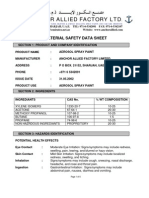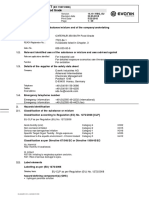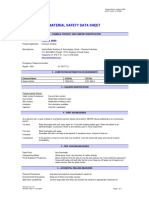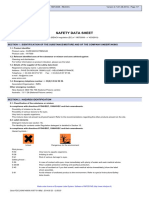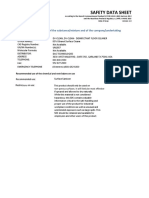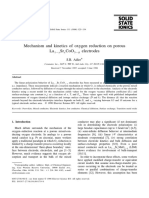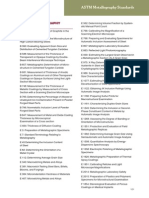MSDS New BERKO SAFE 106 NSF
MSDS New BERKO SAFE 106 NSF
Uploaded by
Alves EdattukaranCopyright:
Available Formats
MSDS New BERKO SAFE 106 NSF
MSDS New BERKO SAFE 106 NSF
Uploaded by
Alves EdattukaranOriginal Title
Copyright
Available Formats
Share this document
Did you find this document useful?
Is this content inappropriate?
Copyright:
Available Formats
MSDS New BERKO SAFE 106 NSF
MSDS New BERKO SAFE 106 NSF
Uploaded by
Alves EdattukaranCopyright:
Available Formats
Material Safety Data Sheet
BERKO SAFE 106 NSF Revision Date:12.07.2017
Reverse Osmosis Antiscalant MUL: 20 mg/L Ref.MSD0203
1. COMPANY IDENTIFICATION
Manufacturer's Name : WETICO – Water & Environment Technologies Co., Ltd.
Address : P O Box 9419, Riyadh 11413, Kingdom of Saudi Arabia.
Emergency Telephone Number : 966-11 240 9777
2. COMPOSITION/INFORMATION ON INGREDIENTS
Composition CAS Number % WT
Mixture of Organophosphonates ---- ----
3. HAZARDS IDENTIFICATION
( EMERGENCY OVERVIEW )
CORROSIVE. CAUSES IRREVERSIBLE EYE DAMAGE OR SKIN BURNS.
HARMFUL IF INHALED, SWALLOWED OR ABSORBED THROUGH SKIN.
Do not get in eyes, on skin or on clothing. Prolonged or frequently
repeated skin contact may cause allergic reaction in some individuals.
Mixers, loaders, and others exposed to this product must wear long-sleeved shirt and long
pants; chemical resistant gloves such as nitrile or butyl rubber; shoes plus socks; goggles and
face shield; and chemical resistant apron. Discard clothing or other absorbent materials that
have been drenched or heavily contaminated with this product's concentrate. Do not reuse
them. Follow manufacturer's instructions for cleaning/maintaining PPE separately from other
such instructions for washables exist, use detergent and hot water. Keep and wash PPE
separately from other laundry. Users should wash hands before eating, drinking, chewing
gum, using tobacco or using the toilet. Users should remove clothing immediately if product
gets inside. Then wash thoroughly and put on clean clothing. Users should remove PPE
immediately after handling the product. Wash the outside of gloves before removing. As soon
as possible, wash thoroughly. Do not apply this product in a way that will contact workers or
other persons. May evolve oxides of carbon (COX), oxides of nitrogen (NOX), Oxides of
phosphates and phosphines under fire conditions. This product is not flammable or
combustible.
Potential Health Effects (Likely route of exposure)
Eye Moderately irritating to eyes, may cause eye burn.
Skin Moderately irritating to skin, may cause skin burns
Inhalation No data available
Ingestion Significant adverse effects are not expected to develop if only small
amounts.
4. First Aid measures
▪ Description of first Aid measures.
Inhalation Remove patient to fresh air, keep warm and at rest, administer oxygen
if necessary.
Skin Contact Thoroughly wash the contaminated skin. Remove the contaminated
clothes and shoes. Consult a doctor if symptoms develop. Wash the
clothes and shoes before reusing them.
Eye contact Immediately wash the eyes thoroughly, opening eyelashes from time
to time. Check if the victim is wearing contact lenses; if yes, remove
them. Wash for at-least 10 minutes. Consult a doctor in case of
irritation.
Ingestion Immediately consult a physician for advice.
▪ Most important symptoms and effects, both acute and delayed. Refer to section 13 for
more information on health effects and symptoms.
▪ Indication of immediate medical attention and special treatment needed: no specific.
5. Fire Fighting measures
▪ Extinguishing media:
Suitable extinguishing media: Water spray, Foam, dry chemical or carbon dioxide
Unsuitable extinguishing media: None Known.
▪ Special Hazards arising from the substance/ mixture:
Decomposes and gives irritant fumes
▪ Advise for fire fighters:
Wear self-contained breathing apparatus and suitable protective clothing.
6. Accidental release measures
▪ Personal precautions, protective equipment and emergency procedures.
Use personal protection recommended; evacuate the spill area safely to
Permit authorized personnel to handle the spill.
▪ Environmental precautions
Keep out of drains and watercourses. Use contaminant walls to contain, reclaim or
Safely dispose of spills. Follow local regulations for safe disposal of contaminated
Absorbent materials and containers. Wash spill areas with water.
▪ Methods and material for containment and cleaning up
Contain large spills with containment walls and transfer the material to appropriate
Container for reclamation or disposal. Collect by sweep, scoop or vacuum and remove.
Flush spill area with water. Small spills can be neutralized with lime or soda followed by
Flushing water.
7. Handling and storage
▪ Precautions for safe handling
Protective measures Handle in accordance with good industrial hygiene and safety practices
as mentioned in section 10.2. These practices include using appropriate
personal protection, avoiding unnecessary exposure and removal of
materials from eyes, thoroughly after handling, avoid breathing vapor or
mist. Emptied containers retain vapor and product residue. Observe all
recommended safety precautions until container for non-industrial
purposes is prohibited and any reuse must be in consideration of the
data provided in this material safety data sheet
Shelf life 24 months
Incompatible Keep away from alkalis, strong oxidizing agents and metals. Provide
materials containment walls of adequate capacity to hold any accidental spills
Suitable packing and SS316L (only for transportation purpose), original containers or metal
storage material containers with glass, PVC, PP, PE or GRP lining
Unsuitable packing Do not store in metal containers such as carbon steel, aluminum etc.
and storage materials
08. Exposure Control / personal protection
▪ Occupational exposure limits
No specific occupational exposure limit has been established.
▪ Exposure controls
Appropriate engineering controls: No specific additional engineering controls are
required. Provide good natural or artificial ventilation.
Eye/ Face protection Use face shield and/or Use face shield and/or chemical goggles. Have
eye wash facilities immediately available at any location where eye
contact can occur.
Skin protection Wear gloves, suitable materials include PVC, Nitrile Rubber, natural
rubber, butyl rubber, and chloroprene and fluorocarbon rubber. Do not
use leather gloves. Wear suitable protective clothing including aprons,
boots, or a suitable acid resistant chemical suit. Wash thoroughly after
handling. Although this product does not present a significant skin
concern, minimize skin contamination by following good industrial
practice.
Respiratory Avoid breathing vapor / mist. Use approved respiratory protection
protection equipment when air borne exposure is excessive.
09. Information on basic physical and chemical properties
Form Liquid
Color Clear to pale yellow
Solubility Miscible in water
Odor Typical
pH @ 25 oC <3
Specific Gravity @ 25 oC 1.15 ــــ1.25
10. Stability and reactivity
Reactivity Reacts vigorously with alkalis, metals and oxidizing agents
Chemical Stability Stable under normal conditions of storage and transport
Possibility of Reacts vigorously with alkalis, metals and oxidizing agents. Can
hazardous reactions liberate flammable hydrogen gas on reaction with metals.
Conditions to avoid Nonspecific
Incompatible material Alkalis, metals and oxidizing agents
Hazardous Carbon monoxide, carbon dioxide, phosphines, phosphorous, oxides
decomposition (PxOy), Nitrogen Oxides (NOx)
products
11. Toxicological information
Acute oral toxicity Species: Rat
Route of administration: Oral
LD50: > 2500 mg/kg
Acute inhalation Not anticipated to be of concern due to low vapor pressure.
toxicity
Acute dermal Species: Rabbit
toxicity Route of administration: Dermal
LD50: > 6,310 mg/kg
Skin irritation No corrosive effects were observed. The result indicates that the test
substance was a mild irritant to rabbit skin.
Serious eye damage In the study which examined eyes up to 14 days, all irritant effects had
/ irritation resolved. From the low degree of irritant effects still present but
reducing in severity at 7 days, it can be predicted that all effects would
have resolved had examination continued to 21 days.
Respiratory irritation Moderate respiratory tract irritation could be anticipated from a
moderate eye irritant
Sensitization Does not cause sensitization of skin.
Repeated dose No classification is proposed for repeated dose toxicity.
toxicity
Carcinogenicity Not expected to be carcinogenic
12. Ecological information
Toxicity potential
Bio- accumulative potential potential
(All values expressed on active acid basis)
13. Disposal Considerations
▪ Waste treatment methods:
All local and national regulations should be followed. Consult regulatory officials for
disposal requirement. For small quantities neutralize with lime or soda ash and flush
away with plenty of water. For large quantities send to special waste disposal system
and burn in proper incinerator. This product should not be dumped in public storage
and sewers / waterways
14. Transport Information
Land Transport (ADR/RID/GGVSE)
UN number UN 3265
Proper shipping name Corrosive liquid, acidic, organic Class 8
Packing group III
Sea Transport (IMDG-code/ GGVSee)
UN number UN 3265
Proper shipping name Corrosive liquid, acidic, organic Class 8
Packing group III
Marine pollutant NO
15. Regulatory information
▪ Safety Phrases :- S 24/25 - Avoid contacts with skin and eyes. S 26 - In case of contact
with eyes, rinse immediately with plenty of water and seek Medical advice.
16. OTHER INFORMATION
NSF INTERNATIONAL
This product has received NSF/International certification under NSF/ANSI.
Standard 60 in the reverse osmosis Anticipant category.
▪ This product material safety data sheet provides health and safety information. The product
is to be used in applications consistent with our product literature. Individuals handling this
product should be informed of the recommended safety precautions and should have access
to this information. For any other uses, exposures should be evaluated so that appropriate
handling practices and training programs can be established to insure safe workplace
operations. Please consult your local sales representative for any further information.
▪ Training advice:
Read the safety data sheet before using the product.
0
▪ NFPA Ratings : 1 1
Health: 1 Flammability: 0 Reactivity: 1 -
▪ Label Hazard Warning :
MAY CAUSE IRRITATION TO SKIN, EYES, AND RESPIRATORY TRACT. MAY BE
HARMFUL IF SWALLOWED OR INHALED.
▪ Label Precautions:
Keep container closed.
Use with adequate ventilation.
Avoid breathing vapor.
Wash thoroughly after handling.
▪ Further information:
The information provided in this Safety Data Sheet is correct to the best of our knowledge,
information and belief at the date of its publication. The information given is designed only
as a guidance for safe handling, use, processing, storage, transportation, disposal and
release and is not to be considered a warranty or quality specification. The information
relates only to the specific material designated and may not be valid for such material.
▪ Sources of key data used to compile the Safety Data Sheet:
Regulations, databases, literature, own tests.
▪ MSDS History:
Revision information.
Created, 30-12-2004
Last Updated, 18-04-2017
You might also like
- Aerosol Paint MsdsDocument6 pagesAerosol Paint MsdsParviz Nasirov50% (4)
- MSDS Oxteril 350 PDFDocument39 pagesMSDS Oxteril 350 PDFgozali100% (1)
- JS 202-2007 المياه العادمة الصناعية المستصلحة PDFDocument30 pagesJS 202-2007 المياه العادمة الصناعية المستصلحة PDFhiba Jamal0% (2)
- Material Safety Data Sheet: Hydrex 2856Document4 pagesMaterial Safety Data Sheet: Hydrex 2856JHUPEL ABARIAL0% (1)
- Gso 149 Unbottled Drinking WaterDocument12 pagesGso 149 Unbottled Drinking Waternizar.e keloth kandi100% (3)
- Cullex Resin MSDSDocument6 pagesCullex Resin MSDSJuan ArcosNo ratings yet
- Material Safety Data Sheet: National Plastic EmulsionDocument2 pagesMaterial Safety Data Sheet: National Plastic EmulsionJHUPEL ABARIAL100% (5)
- MSDS - Hydrex 5914 (Cleaning Chemical) - CO2 PlantDocument4 pagesMSDS - Hydrex 5914 (Cleaning Chemical) - CO2 PlantFAREEDNo ratings yet
- DM Guidelines For Electrical Safety PDFDocument4 pagesDM Guidelines For Electrical Safety PDFHaja Faizunnoor100% (1)
- 01 Conductivity MeterDocument11 pages01 Conductivity MeterSaptarshi Das100% (1)
- Concrete Vibrator Checklist Ver 0Document2 pagesConcrete Vibrator Checklist Ver 0Alves Edattukaran100% (10)
- Crane Inspection ChecklistDocument1 pageCrane Inspection ChecklistAlves Edattukaran50% (2)
- Safety Data Sheet: Section 1. IdentificationDocument11 pagesSafety Data Sheet: Section 1. IdentificationSanthosh GowthamNo ratings yet
- Material Safety Data Sheet: Hydrex 2330Document4 pagesMaterial Safety Data Sheet: Hydrex 2330JHUPEL ABARIAL100% (1)
- Surfanios PremiumDocument7 pagesSurfanios PremiumHeru100% (1)
- Vontron RO Membrane Manual PDFDocument148 pagesVontron RO Membrane Manual PDFkevior2No ratings yet
- HYDREX 7310: Safety Data SheetDocument7 pagesHYDREX 7310: Safety Data Sheetابو محمدNo ratings yet
- Sparkle - Safety Data Sheet (SDS) - 2021 EngDocument4 pagesSparkle - Safety Data Sheet (SDS) - 2021 EngSophie TranNo ratings yet
- Cicocure WBDocument2 pagesCicocure WBMQSWT100% (2)
- Material Safety Data Sheet Product Name: ADVA 380 MSDS ID Number: D-07036 MSDS Date: 05/30/2014Document4 pagesMaterial Safety Data Sheet Product Name: ADVA 380 MSDS ID Number: D-07036 MSDS Date: 05/30/2014Cusid eeNo ratings yet
- Material Safety Data Sheet: 1-IdentificationDocument3 pagesMaterial Safety Data Sheet: 1-IdentificationKhaled Anwar100% (3)
- Jazetal Gloss-MsdsDocument5 pagesJazetal Gloss-MsdsMahmoud Flefil100% (1)
- Mak Hydrol HLP 68 (MSDS)Document5 pagesMak Hydrol HLP 68 (MSDS)holydevil880% (1)
- Shelsol Shoc CardDocument3 pagesShelsol Shoc Cardvinil radhakrishna100% (1)
- 16 HIRA N ERADocument19 pages16 HIRA N ERAriyazaliNo ratings yet
- Sample SOP For PPEs ManagementDocument3 pagesSample SOP For PPEs ManagementAamir ShamasNo ratings yet
- Petromin Product Guide 2019Document184 pagesPetromin Product Guide 2019Mohcine DahbiNo ratings yet
- Sample EHS PolicyDocument1 pageSample EHS Policydeltacris1No ratings yet
- Maxtreat 2925 - MSDSDocument3 pagesMaxtreat 2925 - MSDSLu CianusNo ratings yet
- Grease MSDSDocument6 pagesGrease MSDSAltoz DequitoNo ratings yet
- Safety in PharmaDocument52 pagesSafety in PharmaPrince MoniNo ratings yet
- SDS 3DT180Document10 pagesSDS 3DT180Rahadiyan100% (1)
- Engine Oil MSDSDocument7 pagesEngine Oil MSDSSantos RexNo ratings yet
- Dac - Floor CleanerDocument10 pagesDac - Floor CleanerGopakumar KPNo ratings yet
- DM-PH&SD-P4-TG21 - (Guidelines For Examination and Certification of Cranes, Hoists, Lifts and Other Lifting Appliances) PDFDocument2 pagesDM-PH&SD-P4-TG21 - (Guidelines For Examination and Certification of Cranes, Hoists, Lifts and Other Lifting Appliances) PDFdemie figueroaNo ratings yet
- Av 650 Recent MSDSDocument6 pagesAv 650 Recent MSDSMounir BoutaghaneNo ratings yet
- 3340-Sds-Petromin Atf Dexron Ii e V#2Document6 pages3340-Sds-Petromin Atf Dexron Ii e V#2SICIM SAUDI ARABIANo ratings yet
- HSE-Iran Power PlantDocument40 pagesHSE-Iran Power PlantDivya Sankaranarayanan100% (1)
- WCO&PED Management Inspection Demobilization Audit ChecklistDocument2 pagesWCO&PED Management Inspection Demobilization Audit ChecklistFarhat SetharNo ratings yet
- Wem Aw 011: Method StatementDocument5 pagesWem Aw 011: Method StatementPrinterHaapcol100% (1)
- DO's & Dont'sDocument5 pagesDO's & Dont'sSimbu ArasanNo ratings yet
- EHS in Pharmaceutical IndustryDocument19 pagesEHS in Pharmaceutical IndustryARPITA MISHRA100% (1)
- Fosroc - Nitocote PE 135Document8 pagesFosroc - Nitocote PE 135guru sathya bharathyNo ratings yet
- 5600 Turbomaster XD 15W 40 CI 4Document3 pages5600 Turbomaster XD 15W 40 CI 4elnhhas720% (1)
- Petromin Product GuideDocument169 pagesPetromin Product Guidebilal mostafaNo ratings yet
- Safety Data Sheet: 1. Identification of The Substance/preparation and Company Sika Bond DVDocument3 pagesSafety Data Sheet: 1. Identification of The Substance/preparation and Company Sika Bond DVKhaled Anwar100% (1)
- Hydrex 7310Document3 pagesHydrex 7310Abd kab100% (2)
- Formaldehyde SurveyDocument358 pagesFormaldehyde SurveyMohd Nor AriffinNo ratings yet
- Dettol Antiseptic Liquid v7.2 D0059298Document11 pagesDettol Antiseptic Liquid v7.2 D0059298aningNo ratings yet
- Safra PineDocument3 pagesSafra PineTanzeel Liaqat100% (5)
- Sop For Procedure For BreakdownDocument4 pagesSop For Procedure For BreakdownYATHISH BABUNo ratings yet
- SOP TomyAutoclaveDocument2 pagesSOP TomyAutoclavelinhpic32No ratings yet
- (Draft) Guideline For Handling, Storage and Transport of EquipmentDocument5 pages(Draft) Guideline For Handling, Storage and Transport of EquipmentAnonymous QqPWzcopI100% (2)
- Copy (2) of Dubai Municipality - Swimming Pool SafetyDocument7 pagesCopy (2) of Dubai Municipality - Swimming Pool Safetyabokoraa100% (7)
- Hazchem CodingDocument5 pagesHazchem CodingrmaffireschoolNo ratings yet
- SOPDocument5 pagesSOPMd Nazmus SakibNo ratings yet
- MSDS PC 22 Radiator CoolantDocument4 pagesMSDS PC 22 Radiator CoolantAldiNo ratings yet
- Oven, Gril CleanerDocument5 pagesOven, Gril Cleanerمحمد عطيةNo ratings yet
- Safety Data Sheet: Tokyo Chemical Industry Co., LTDDocument4 pagesSafety Data Sheet: Tokyo Chemical Industry Co., LTDLee KooNo ratings yet
- Dq-sch2s SdsDocument6 pagesDq-sch2s SdsChristian ArizaNo ratings yet
- Safe Boost SDSDocument3 pagesSafe Boost SDSmohamed.salamaNo ratings yet
- Enterprise Risk Management (ERM) : A New Way of Looking at Risk Management at An Organisational LevelDocument19 pagesEnterprise Risk Management (ERM) : A New Way of Looking at Risk Management at An Organisational LevelAlves EdattukaranNo ratings yet
- Enterprise Risk Management A Best PractiDocument15 pagesEnterprise Risk Management A Best PractiAlves EdattukaranNo ratings yet
- Dialnet EnterpriseRiskManagement 8403330Document24 pagesDialnet EnterpriseRiskManagement 8403330Alves EdattukaranNo ratings yet
- Safety Data Sheet: Masterflow 648 Part C Also Masterflow 648Cp Plus Part CDocument8 pagesSafety Data Sheet: Masterflow 648 Part C Also Masterflow 648Cp Plus Part CAlves EdattukaranNo ratings yet
- Safety Data Sheet: Masterflow 648 Part B Also Masterflow 648Cp Plus GRT PTBDocument7 pagesSafety Data Sheet: Masterflow 648 Part B Also Masterflow 648Cp Plus GRT PTBAlves EdattukaranNo ratings yet
- MSDS New CAUSTIC SODADocument6 pagesMSDS New CAUSTIC SODAAlves EdattukaranNo ratings yet
- Oxy Welding/Cutting Equipment Risk Assessment: October 2014 //1Document2 pagesOxy Welding/Cutting Equipment Risk Assessment: October 2014 //1Alves EdattukaranNo ratings yet
- Critical Success Factors For Safety Program Implementation Among Construction Companies in Saudi ArabiaDocument8 pagesCritical Success Factors For Safety Program Implementation Among Construction Companies in Saudi ArabiaAlves EdattukaranNo ratings yet
- Fosroc Thioflex 600 Pouring Grade Base: Safety Data SheetDocument7 pagesFosroc Thioflex 600 Pouring Grade Base: Safety Data SheetAlves EdattukaranNo ratings yet
- Morpholine MSDSDocument7 pagesMorpholine MSDSAlves EdattukaranNo ratings yet
- Employee Trust & Workplace Performance - Research JournalDocument18 pagesEmployee Trust & Workplace Performance - Research JournalAlves EdattukaranNo ratings yet
- Scaffold Inspection ChecklistDocument1 pageScaffold Inspection ChecklistAlves Edattukaran100% (5)
- Plate Compactor (Electric) Checklist Drafted For Shapar.Document3 pagesPlate Compactor (Electric) Checklist Drafted For Shapar.Alves Edattukaran100% (1)
- Boom Placer ChecklistDocument3 pagesBoom Placer ChecklistAlves Edattukaran100% (3)
- Halogen FamilyDocument22 pagesHalogen FamilyArpit PatelNo ratings yet
- IS Code For Steel Bin Design - 9178Document29 pagesIS Code For Steel Bin Design - 9178krishna kumar50% (2)
- Charpy V Notch Impact TestDocument5 pagesCharpy V Notch Impact TestAlsonChin100% (1)
- A Report On Green Material - Hempcrete: HempDocument6 pagesA Report On Green Material - Hempcrete: HempvaibhavNo ratings yet
- Crusher OverViewDocument26 pagesCrusher OverViewAhmad Y. AbughaushNo ratings yet
- Mechanism and Kinetics of Oxygen Reduction On Porous La SR Coo ElectrodesDocument10 pagesMechanism and Kinetics of Oxygen Reduction On Porous La SR Coo ElectrodessinytellsNo ratings yet
- Unit 4 MEEDocument23 pagesUnit 4 MEEdipak1980No ratings yet
- Item No. Description of Works QTY Unit Unit Cost Amount (P)Document29 pagesItem No. Description of Works QTY Unit Unit Cost Amount (P)AYSON N. DELA CRUZNo ratings yet
- 121 ASTM ISO StandardsDocument3 pages121 ASTM ISO StandardsHestu Adi WicaksonoNo ratings yet
- E-Shell® 300 Series - 3D Printing Materials - EnvisionTECDocument3 pagesE-Shell® 300 Series - 3D Printing Materials - EnvisionTECdamboNo ratings yet
- FEECO Agglomeration SolutionsDocument8 pagesFEECO Agglomeration SolutionsRafael RiosNo ratings yet
- DHDSDocument4 pagesDHDSThirumal ThirandasNo ratings yet
- SCI P259 The Fire Resistance of Concrete Filled Tubes To Eurocode 4 2000Document34 pagesSCI P259 The Fire Resistance of Concrete Filled Tubes To Eurocode 4 2000metroxNo ratings yet
- Eam of Analysis EditedDocument140 pagesEam of Analysis EditedAvishek KumarNo ratings yet
- Answer Two Questions From Section A, One Question From Section B, Two Questions From Section C and One Other Question. Section ADocument6 pagesAnswer Two Questions From Section A, One Question From Section B, Two Questions From Section C and One Other Question. Section AKarren MakamureNo ratings yet
- 1 Introduction To Soil ChemistryDocument16 pages1 Introduction To Soil ChemistryJohn Mark Gocon Gocon100% (1)
- Coefficient of Consolidation and Its CorDocument6 pagesCoefficient of Consolidation and Its CorMD Anan MorshedNo ratings yet
- Heat and Mass Transfer NotesDocument40 pagesHeat and Mass Transfer NotesBALAMUGUNDAN78% (23)
- MCHW NG Annex1 ExampleDocument37 pagesMCHW NG Annex1 ExampleGovind BishtNo ratings yet
- Gestra Steam Trap - Thermostatic Steam Trap BK 29: Class Rating: ANSI 900 Available SizesDocument2 pagesGestra Steam Trap - Thermostatic Steam Trap BK 29: Class Rating: ANSI 900 Available SizesdcarunchioNo ratings yet
- Co-Ordination Compound Ex-4 Solution For Vedantu TatvaDocument9 pagesCo-Ordination Compound Ex-4 Solution For Vedantu TatvaAbhinav ThapliyalNo ratings yet
- A Guide To Anti Vibration Products For FastenersDocument7 pagesA Guide To Anti Vibration Products For Fastenersmehar baba badeNo ratings yet
- Acid Bases and Salts: Previous Years' CBSE Board QuestionsDocument46 pagesAcid Bases and Salts: Previous Years' CBSE Board QuestionsRomesh SijaNo ratings yet
- Project Proposal RRCDocument2 pagesProject Proposal RRCRoniel Urbino GamboaNo ratings yet
- 02Document319 pages02Jopheth RelucioNo ratings yet
- Electronic Devices and Electronic Circuits: QuestionsDocument51 pagesElectronic Devices and Electronic Circuits: QuestionsRohit SahuNo ratings yet
- DESIGN SPECIFICATIONS FOR HIGHWAY BRIDGES 2002 (Japan)Document92 pagesDESIGN SPECIFICATIONS FOR HIGHWAY BRIDGES 2002 (Japan)이동욱100% (1)
- Chemistry of Noble GasesDocument26 pagesChemistry of Noble GasesjaqNo ratings yet
- Valve Material EquivalenceDocument2 pagesValve Material EquivalenceTran Duc NghiaNo ratings yet
